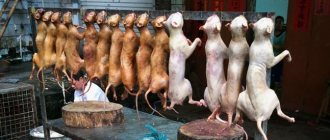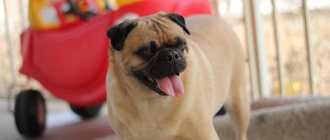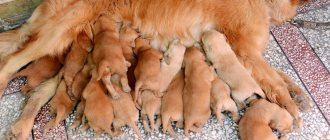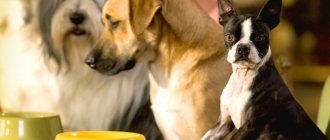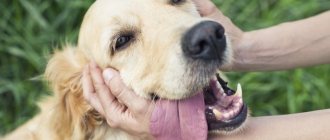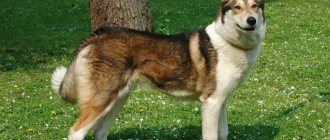Fans of miniature dogs with luxurious snow-white fur were the ancient Greek philosopher Aristotle and the French queen Marie Antoinette. Maltese dogs are still very popular among dog lovers, who value them not only for their attractive appearance, but also for their friendly, easy-going character.
To keep your pet healthy and always look well-groomed, you need to pay attention not only to caring for its long, white fur, but also to choose the right feeding strategy for your pet.
How to feed
To grow up healthy and happy, pets need a balanced diet rich in proteins, fats, and carbohydrates. The daily intake of such a delicacy provides the animal with a sufficient amount of fiber, vitamins, and minerals and is determined at the rate of one tablespoon per 500 grams of the animal’s weight.
Premium small dog foods often include chicken and brown rice. They are enriched with a complex of antioxidants that help support the immune system and muscle development of pets.
If your Maltese has a sensitive stomach or is prone to allergies, it is best to choose a grain-free dog food. For dogs with allergies, manufacturers offer a combination of chicken meat with broccoli, spinach, blueberries, carrots or apples.
An indicator of the quality of dry food is the absence of by-products, flavorings and preservatives, wheat or soy.
Grocery list
- Porridge made from rice, buckwheat, oatmeal, pearl barley, and rolled oats flakes;
- Fresh herbs - parsley, dill, cilantro;
- Fermented milk products (kefir, cottage cheese, natural yogurt);
- Meat products (lean pork, beef, chicken or turkey);
- Beef or pork by-products;
- Cartilaginous components of the joints and throat;
- Vegetables (carrots, tomatoes, cucumbers, zucchini, pumpkin);
- Boiled chicken egg whites. Yolks are sometimes possible and only after one and a half years of age;
- Sea fish, as there are too many bones in the river fish.
For breakfast, the dog is cooked porridge, mixing it with pieces of boiled meat and vegetables. Add chopped greens and a few drops of vegetable oil to the food. In addition, it is recommended to add a few drops of a mixture of fat-soluble vitamins - trivit or tetravit.
For dinner, you can offer your pet low-fat cottage cheese, boiled egg white or boiled sea fish.
A couple of times a week, you can pamper your snow-white friend with a vitamin salad made from nuts, honey and finely chopped dried apricots or prunes.
When feeding your pet natural food, vitamins should be given with food. Water-soluble ones are given directly, like candy, and fat-soluble ones are added to food.
In older dogs, the need for plant fiber increases, so more vegetables and dairy products are introduced into their menu, and cereals and meat are given in limited quantities.
The French and British developed a special diet for the snow-white creatures. The staples of the English diet are goat's milk, porridge and scrambled eggs. French Maltese fans suggest feeding their miniature pets chicken or beef, cottage cheese and fresh fruits and vegetables.
If the owner decides to choose a French or English diet as food, then he should remember that the puppy must be accustomed to such feeding from a young age so that the dog gets used to such a diet normally.
1st Choice Breeders for miniature breeds with chicken (20kg)
The best option among super-premium feeds. It consists of high-quality meat, vegetables, and does not contain unnecessary third-rate components and by-products. The composition does not contain taste or smell enhancers or other artificial additives.
The price per kilogram (366 rubles/kg) is budget-friendly for a product of this quality. Product, there is a huge range of food for small breeds with other tastes, hypoallergenic types that are suitable for animals with a tendency to allergies.
pros
- There is no unpleasant smell, the animal’s mouth does not smell after eating;
- The condition of the coat improves;
- Does not cause digestive upset, suitable for animals with a weak gastrointestinal tract;
- Each product in the line is balanced according to the age of the animal for which it is intended (this product for adult miniature dogs contains the required 22% protein);
- Does not cause allergies;
- Convenient packaging with a clasp, the product does not run out.
Minuses
- It has the form of granules, which are much more difficult to digest when not chewed;
- Difficult to find in pet stores.
ProNature Holistic (for miniature breeds) (0.34 kg)
The best option from holisticists. The composition contains minerals, animal proteins, trace elements, vitamins. Consists of meat, fish, egg products, berries, fruits, vegetables, does not contain corn, wheat, soy, or other grains.
There are no chemical preservatives, aroma or taste enhancers. Veterinarians consider the products of this brand to be among the best for the constant feeding of miniature breed dogs.
pros
- High calorie content, the dog remains full for a long time, eating a small portion;
- The appearance of the coat improves with constant holistic nutrition;
- No problems with the gastrointestinal tract, well absorbed by the animal’s body;
- Suitable for dogs with intolerance to certain foods;
- After eating, the animal's mouth does not smell;
- The small package has a convenient clasp, the food does not run out.
- Does not cause allergies;
- Convenient packaging with a clasp, the product does not run out.
Minuses
- Not found in all pet stores.
Industrial feed
Dry and wet food for Maltese can be given from two months of age. Many companies produce high-quality food for puppies. Such canned food and granules are designed taking into account the growth of bones and teeth, high activity and curiosity of children. Before serving, soften the crispy pads in milk and heat the meat jelly to 40°.
Only premium and super premium food is suitable for lap dogs. They consist of high-quality hypoallergenic ingredients and are divided into categories taking into account the age, breed, and health status of the animal.
Veterinarians have compiled a food rating for Maltese dogs.
Royal Canin
The French company Royal Canin has developed food for adult Maltese dogs (from 10 months). It contains the exclusive Maltese Adult formula, which takes care of the whiteness and softness of the dog's coat. The crunchy texture of the granules cleanses the interdental space, and the rich taste of the meat will please the most picky pet.
Akana
The Canadian company Acana produces super premium food for Maltese. All ingredients for the granules are grown on local farms, ponds, fields, and gardens. Akan food contains additives to strengthen the dog's stool. Thanks to this, after bowel movements, the lapdog's coat remains snow-white.
Another Canadian company, Now, has received recognition from veterinarians and dog owners around the world.
Their Maltese food is holistic and does not contain grains. Thus, they reduced calorie content and the likelihood of allergic reactions. They replaced cereals with potatoes, vegetables, fruits, and berries.
Grandorf
Grandorf food belongs to the super premium category. For Maltese, they developed kibble based on rabbit, turkey and sweet potato. Additional components - rice, vegetables, fruits, herbs. Protein dehydrolysis and Fresh Pack packaging help preserve the taste and benefits of the product for a long time.
Hills
Hill's food was developed in the USA and produced in Holland. Veterinarians can recommend his products “For adult miniature breed dogs” to owners of Maltese dogs. The main component of the product is dried chicken and turkey meat. The granules are enriched with calcium, sodium, phosphorus, Omega-3 and Omega-6 fatty acids.
Orijen Original (6 kg)
Super premium product, suitable for all breeds, including small ones. Includes high-quality fish and meat, the content of which reaches a record 80% among other dry food, healthy herbs (dandelion, mint, turmeric).
All these ingredients help strengthen canine immunity. Does not contain third-rate by-products, chemical preservatives, flavor enhancers, aroma, vegetable proteins, gluten, or cereals. Orijen is suitable for active miniature dogs.
pros
- Record high animal protein content;
- Does not cause allergies;
- The composition contains several types of fish.
Minuses
- There is no fastener on the packaging so that the food does not dry out; it will have to be poured into a closed container;
- Strong odor and noticeable but short-lived odor from the animal's mouth;
- Rarely, problems with the gastrointestinal tract are possible.
Natural food
The Maltese dog's diet should be balanced and include the optimal amount of fats, proteins and carbohydrates. Feeding with natural food meets this criterion and has a number of advantages. The owner himself selects and purchases the necessary products, so he is confident in their freshness. Such nutrition is cheaper than specialized food and is easy to adjust.
Authorized Products
It’s not difficult to cover your pet’s needs with natural food. The Maltese will eat almost anything available at home.
The following foods are acceptable for dogs of this breed:
- Meat. The main component in the animal’s diet, therefore it is given daily in boiled form. It is better to choose less fatty varieties, such as turkey, rabbit or veal. By-products are allowed.
- Fish. Mostly sea fish rich in omega-3 is used. It is important to ensure that there are no bones in the fillet. Steamed.
- Vegetables. The main component that Maltese nutrition cannot do without. Zucchini, tomatoes, cucumbers, pumpkin, and carrots contain many vitamins, fiber and are a favorite treat of this breed. Pre-boil and cut into small pieces.
- Greenery . Parsley, dill, lettuce or green onions will do. Used fresh as an addition to dishes.
- Porridge. Cooked on the basis of rice, buckwheat, oatmeal or barley, with or without the addition of milk. Veterinarians advise avoiding millet, as it is difficult to digest. Only puppies eat semolina; it is important that it is well boiled. May cause allergies in adult dogs.
- Chicken eggs. It is better to feed a lapdog only boiled proteins. Yolks are acceptable at one and a half years of age in rare cases.
- Fruits. They are given not only for encouragement, but also as a separate meal. The Maltese prefers apples, pears and even melons. If your pet eats other fruits, such as plums or citrus fruits, there is no need to ban them. In order for the treat to be beneficial, it is necessary to monitor the body’s reaction. Allergies or digestive problems require dietary changes.
- Milk. Helps strengthen the skeleton and improve metabolic processes. Maltese puppies are fed primarily with cow's milk. For young dogs, low-fat cottage cheese, sour cream, and cheese are suitable. Laps of all ages need kefir. It is well absorbed and has a beneficial effect on the functioning of the gastrointestinal tract.
It is not recommended to feed your dog chicken. The meat of this bird is considered a strong allergen for the Maltese dog. It can cause problems with hair or skin, and cause respiratory system problems.
From the listed products you can prepare milk porridge, supplemented with berries and fruits, light soups, cereals with vegetables, meat or fish. Dogs love variety in food and enjoy new dishes.
Prohibited Products
Despite the fact that the Maltese dog's diet includes many different foods, there are also restrictions. It is forbidden to give Maltese:
- chocolate, confectionery;
- fatty meats, bones;
- sausage, frankfurters and semi-finished products;
- baking;
- spicy and seasoned foods;
- legumes;
- potato.
A common mistake in feeding pets is giving treats and handouts from the common table. Regular food contains concentrations of salt and sugar that are unacceptable for dogs. In addition, dishes can be fatty or fried, which will cause significant harm to your pet's health.
Stern
Purchased food for the Maltese is a priority for most breeders of this breed. It is balanced and includes all the necessary beneficial components, vitamins and minerals. No need to think about what to cook for your dog for breakfast or dinner. This greatly simplifies the task and saves time.
Types of feed
What food is best for a Maltese dog is determined by the owner, based on the advice of a veterinarian. An incorrectly selected product can cause watery eyes and digestive problems.
Dry food for Maltese is divided into classes, depending on the price and quality of the product:
- Economy class. Produced from second-class raw materials of low quality. The main components are soybeans and waste left over from the food industry. This food is less digestible and can cause an allergic reaction and stomach upset. Economy brands include the famous Pedigree or Chappi brands.
- Premium class . Low quality product with a high proportion of protein component. Animals usually like it due to the large number of flavor enhancers and a strong, attractive smell. In stores you can find Purina, Advance.
- Super premium . It is based on natural meat, cereals, and healthy additives that improve digestion. They are produced taking into account different ages and physiological characteristics. Produced by the brands Nutra Gold and Belcando. Super premium food for Maltese is considered the most favorable. It covers the needs of the Maltese dog and is reasonably priced.
- Holistic class - the best food of the highest quality. Well balanced, enriched with vitamins and minerals. Thanks to probiotics, it improves the functioning of the gastrointestinal tract. The main ingredients include natural meat and premium grains. For small dogs, Acana small or Wellness Simple are suitable.
In addition to dry food, the lapdog prefers canned meat, as well as special treats in the form of cookies and bones for dogs. The latter are intended for the prevention of tartar, development and strengthening of the jaw.
The diet of neutered pets should consist of food for sterilized dogs.
Go! Natural Holistic (holistic menu) Go & NOW Natural (690 g)
Suitable for all dog breeds, especially miniature ones. It contains only natural ingredients, calf meat, turkey, lamb, duck, fruits, berries, vegetables.
The product is perfectly balanced, the necessary animal proteins, carbohydrates, fiber, microelements, acids are present, there are no harmful soybeans, preservatives, odor and taste enhancers, or low-quality by-products. All components retain their properties thanks to gentle processing.
pros
- Convenient sealed packaging with a zipper: the food does not expire and does not lose its properties;
- The amount of excrement is significantly reduced, and its smell becomes less pronounced;
- High calorie content, the dog remains full for a long time;
- The coat becomes more shiny and smooth in appearance with prolonged constant feeding;
- Does not cause allergies or dental problems;
- The condition of the skin and eyes improves noticeably over time;
- Can be found in every pet store;
- Does not have a pronounced odor.
Minuses
- Large granules that are difficult to digest if the dog does not chew them;
- Possible odor from the animal's mouth;
- Occasionally, problems with the gastrointestinal tract occur.
Diseases
Unfortunately, this breed has a considerable list of diseases. These cute dogs suffer from diseases of the eyes, teeth, heart, stomach, as well as eclampsia and allergies. It is important to know the decoding of symptoms in order to properly help your pet.
Symptoms
Urine with blood
An alarming situation is when the lap dog is hiccupping and blood is released in the urine. This indicates possible cystitis or cancer in the dog. Without professional diagnosis and consultation with a doctor, it is impossible to identify the exact cause of these symptoms. Self-medication is strictly prohibited.
What to do when your eyes are running?
Glaucoma is the most common disease in which there is excessive tearing, strabismus, enlargement of the eyeball, blindness, and acute pain. Glaucoma is caused by a violation of the outflow of fluid from the chambers of the eye. The pressure rises, the retina is destroyed, and ischemia of the eye tissue occurs. You should consult your doctor immediately to get the right advice and treatment.
Seething in the stomach
This is an upset stomach. Caused by illiterate feeding, for example, a combination of dry food with natural food. Usually the dog refuses food for several days . But after a meal, stool appears with a large amount of elastic mucus. You should choose one type of food and make your pet drink more boiled water. Medicines are prescribed only by a doctor.
Gases
This is flatulence, which has similar symptoms and causes of appearance with seething in the stomach. However, gases can also be caused by poisoning.
Treatment
Prevention of diseases is the best treatment. The action plan is as follows:
- undergo an oral examination 2 times a year;
- carry out annual sanitation of the Maltese’s oral cavity;
- undergo echocardiographic examination 2 times a year;
- regularly measure intraocular pressure.
If your dog suddenly becomes lethargic, apathetic and refuses to eat, then immediately visit a veterinarian. Only a specialist will determine the exact cause of the ailment, announce the diagnosis and prescribe treatment.
Attention! When walking with Snow White, you need to carefully monitor her behavior. You should not allow the dog to eat from the ground, eat unknown grass, and so on. Otherwise there is a risk of poisoning.
Ontario Mini Weight Control with Turkey and Potatoes (2.25 kg)
Czech super-premium product. Recommended by veterinarians due to its perfectly balanced composition. Does not contain cereals or grains. The composition includes high-quality fish, meat products, vegetables (for example, tomatoes).
There are no low-quality ingredients, chemical preservatives, or meat and bone meal. Suitable for dogs with excess weight problems.
pros
- High content of lycopenes;
- Suitable for dogs with poor health, problems with joints and immunity;
- Does not cause a bad odor from the animal's mouth;
- All useful microelements in the form of chelates are absorbed by the dog’s body 100%;
- Small granules that are easy to digest;
- Distributed in pet stores;
- Hermetically sealed packaging.
Minuses
- Pronounced smell.
Reviews
Olga, Lipetsk
“My Maltese Molly is a very picky eater. Through trial and error, we found the right Royal Canin food for her. She eats it with pleasure and feels good.”
Tatiana, Saratov
“The breeders advised me to buy Grandorf food. However, it has rather large, awkward granules. I soak them in water and give them to the lapdog as a soft porridge. Now I’m thinking about switching to a different diet.”
Natalya, Gvardeysk
“All my cats and dogs eat Akana food. The Maltese also enjoys eating dry kibble. They are easy to store and measure portions. The price is a little high, but for my kids I don’t mind.”
Small, cute dogs with long, crystal white hair have proven to be popular with many breeders. The Maltese is renowned for its beauty, gentle nature, loyalty and receptiveness to training. To keep your pet healthy, you need some care. It consists not only of walking, training and wool processing, but also of proper nutrition suitable for this breed. It is necessary to find out what to feed your Maltese to support digestion and improve well-being.
Acana Heritage (6 kg) (for small breeds)
This Canadian product is a good choice for a miniature breed dog. It is suitable for both active animals and completely lazy ones. The food is holistic, that is, it contains only natural ingredients.
There are no cheap low-quality components in the products of this brand; feed wheat and bone meal are completely absent. Contains only meat, fish, vegetables, fruits, and high quality dairy products.
pros
- High concentration of animal proteins;
- Fresh ingredients;
- There are no carbohydrates (the dog’s body does not need them);
- A variety of fruits, vegetables, tonic herbs in the composition, which strengthen the heart and improve the condition of the gastrointestinal tract;
- Reduces insulin levels, strengthens the liver;
- High quality packaging.
Minuses
- May cause allergies;
- Noticeable fishy smell;
- High fat content.
Wolfsblut Gray Peak Small Breed (15 kg)
German quality holistic specialist. The products of this brand include only those components that are easily absorbed by the dog’s body, without causing any digestive problems.
zdorove/pitanie/luchshih-suhih-kormov-dlya-maltiyskoy-bolonki.html
No wheat, oats, corn, starch or gluten. Meat makes up more than half of the food - cod, mackerel, haddock, pheasant, rabbit, trout, salmon, lamb.
pros
- Excellent balance of vitamins, minerals, healthy supplements;
- Complete absence of chemical ingredients (flavor and aroma enhancers and dyes);
- Moderate size granules;
- No noticeable odor;
- Elegant, high quality packaging;
- The company has an official website with a detailed description of the product and instructions;
- The condition of the coat improves.
Minuses
- Rarely available in pet stores;
- In isolated cases may cause constipation
Grandorf (3 kg) Lamb with rice Mini
Suitable for a small breed dog. Veterinarians often mention this brand as the most suitable for dogs prone to allergies. The composition is completely free of chicken and grains.
In addition to meat, it contains components such as vegetables and grains. It is better to take this food for an active dog. If she is lazy, then Grandorf will make her overweight.
pros
- High meat content - >60%;
- High calorie content, the dog will be full for a long time;
- No chemical flavors or additives;
- Improves the condition of the gastrointestinal tract, restores intestinal microflora (and is even indicated for those dogs who have digestive problems);
- Improves the condition of the coat.
Minuses
- High in fat, a lazy dog will quickly gain weight.
Nutrition for adult and elderly dogs
A two-month-old puppy eats 5-6 times a day. Gradually the number of feedings is reduced. By 12 months he should be on two meals a day. Sample menu for an adult dog:
- The first feeding is cottage cheese with one yolk and pieces of fruit.
- second feeding - buckwheat porridge with chicken breast, seasoned with vegetable oil.
To correctly calculate the serving size in grams, examine the dog. She should not have a hanging belly or protruding ribs. If the animal has been sterilized, reduce the caloric content of meals and increase the walking time.
The lifespan of Maltese dogs is 14-16 years. After reaching eight years of age, the dog is already considered elderly and needs changes in diet. Meat should be easily digestible by the body (boiled chicken, turkey, veal). And you need to add more steamed vegetables to porridges to help the intestines work.
Royal Canin for healthy skin and coat 2 kg (for small breeds)
Famous French super-premium food. It is of good quality, but lower than that of competitors (discussed in paragraphs 1-9).
Royal Canin Mini contains grains and vegetable proteins.
pros
- Does not cause allergies;
- Nutritious, but does not cause excess weight in the animal (the energy intensity of the diet and the protein content in the product are precisely calculated);
- Available at many pet stores;
- High-quality packaging;
- Moderate size granules;
- Restoring the condition of the coat;
- Contains sodium polyphosphate, which prevents the formation of plaque;
- The composition includes many useful microelements;
- Improved digestion.
Minuses
- With constant feeding of this food, it is impossible to do without additional supplements with vitamins and microelements;
- Inconvenient packaging without fastener;
- Contains poorly digestible grains and artificial additives (preservatives, dyes.);
Among these foods, the best choices for a miniature animal would be 1st Choice Breeders Miniature Breed with Chicken (20kg) and Wolfsblut Gray Peak Small Breed (15kg).
The first is the highest quality, and at the same time inexpensive, super-premium food.
The second is a natural holistic company, and the company has a detailed official website with all the information on the food and instructions.
Both products have a minimum of disadvantages, which are offset by advantages from the balance of nutrients, vitamins, microelements and the absence of harmful preservatives to convenient packaging.
Rating of the 10 best dry food for Maltese dogs
| Place | Name | Rating | Price, rub. |
| 1 | 1st Choice Breeders for miniature breeds with chicken (20kg) | 5.0 / 5 | 7335 |
| 2 | ProNature Holistic (for miniature breeds) (0.34 kg) | 5.0 / 5 | 435 |
| 3 | Orijen Original (6 kg) | 4.9 / 5 | 3840 |
| 4 | Go! Natural Holistic (holistic menu) Go & NOW Natural (690 g) | 4.9 / 5 | 424 |
| 5 | Ontario "Mini Weight Control" for small breed dogs, with turkey and potatoes (2.25 kg) | 4.8 / 5 | 799 |
| 6 | NOW FRESH salmon, duck, turkey (2.72 kg) (for miniature breeds) | 4.8 / 5 | 1569 |
| 7 | Acana Heritage (6 kg) (for small breeds) | 4.8 / 5 | 3404 |
| 8 | Wolfsblut Gray Peak Small Breed (15 kg) | 4.8 / 5 | 6342 |
| 9 | Grandorf (3 kg) Lamb with rice Mini | 4.7 / 5 | 1600 |
| 10 | Royal Canin for healthy skin and coat 2 kg (for small breeds) | 4.7 / 5 | 625 |
Feeding tips for miniature dogs
To maintain the health of a small dog, it is important to consider recommendations and advice on feeding and managing the animal’s diet:
- It is advisable for miniature breeds to eat dry food daily.
This is due to the fact that they often experience oral diseases: inflammation of the gums, unpleasant odor from the mouth, loose teeth, and excessive deposits of tartar. Diseases develop faster than in large individuals. Preference is given to holistic feeds; they do not contain dyes, preservatives, or by-products. Dry food reduces the risk of these diseases, but is not a panacea. - The diet should include wet food.
Miniature dogs are prone to diseases of the urinary system; due to their size, the kidneys produce a small amount of urine, which contains a concentration of harmful inorganic substances. Wet food helps saturate the body with additional fluid and prevents the appearance of formations in the urinary system. It is not advisable to mix dry and wet food; it is better to offer them to the animal at different times. - Do not choose your own nutritional supplements for the animal and do not give food from your table.
The advantage of ready-made dry food is its balance. The substances your dog needs are available in the right quantities. Homemade table food contains a lot of salt, fat, spices, and other substances harmful to the animal. A dog whose diet is based on dry food does not need additional biological additives. An excess of vitamins is more harmful than their deficiency. - Do not overfeed.
Small individuals have a tendency to become obese. If you do not control the number of servings in the bowl, then over time the animal may become overweight. On packages of ready-made dry food there is a table on portion sizes and feeding frequency. Compliance with these standards will protect your dog from weight problems.
Features of feeding adult Maltese
If you have a Maltese dog, the amount of food from 6 months onwards will be slightly different. With a weight of 2.5 to 3 kilograms, at least 150 grams of feed will be required daily for feeding.
What should a Maltese eat?
No matter how old your Maltese dog is, there are some foods that should never be included in their diet. This:
- Sweets, smoked foods, pickles, hot and spicy foods.
- Meat with bones.
- Pickled vegetables, sausages.
- Chocolate and chocolate candies.
- Spicy cheeses, cakes and pastries are contraindicated.
Potatoes, any varieties of cabbage, green peas are undesirable. It's better not to risk your pet's health. If the dog has just been running or playing, it should not be fed immediately, as this may result in vomiting.
Maltese breeders recommend
People who breed dogs, including Maltese dogs, most often use ready-made food for feeding in their factories. After all, they are balanced in components and do not contain products that can provoke an allergic reaction. Moreover, with professional food, the time associated with satiation of pets is reduced.
Animals eat such food with pleasure. Among the prepared foods there are also special dog treats, which include cookies. It can be given after the main meal. These treats should not contain manganese.
The amount of food needed per feeding is indicated on the package. When accustoming to a new coma begins, it is added in minimal doses. It is imperative to monitor the dog's condition. If red spots appear under the eyes, you should stop introducing this food.
Choose the right diet, your pets will delight you with their healthy appearance, snow-white silky fur and activity.
What vitamins are needed when feeding small breed dogs
If the dog’s diet consists of natural food, ready-made vitamin complexes will serve as an additional source of vitamins and minerals. There are many types of multivitamins and specialty vitamins on the pet market designed for small dog breeds.
The vitamin multicomplex solves the problem of vitamin deficiency in the body of an adult animal.
For example, Farmavit Active, Wolmar Winsome Pro Bio Booster Ca Mini or Galakan Champion. These nutritional supplements are developed for small breed dogs, are hypoallergenic, and do not cause side effects.
How to properly feed small breed dog puppies
When a puppy is just born, its digestive system is on its way to development; a diet of the right foods is the key to health for years to come. Newborn puppies can be supplemented with milk or a specialized formula. At the age of about 1-3 months, you need to feed puppies with natural food: lean meat, eggs, fish, porridge, fermented milk.
Protein should make up at least 70% of the diet. We add healthy fats and boiled vegetables to the rest of the diet. This menu may seem boring to humans, but puppies do not need a variety of foods.
Their gastrointestinal tract is just learning how to digest food, and preference is given to simple and healthy foods. The diet should not contain fatty, fried, sweet foods; they are prohibited for puppies and cause serious health and digestive problems.
Diet features
The Maltese is a very picky eater. She may completely refuse dry food pellets or natural food dishes. The owner will have to create an individual diet based on the pet’s preferences.
In this case, it is necessary to take into account:
- calorie content of dishes;
- nutritional balance;
- daily regime;
- presence of vitamins and minerals in the feed.
When buying a Maltese puppy, ask the breeders what they fed it in the kennel and what food the dog’s parents prefer.
If your miniature dog has digestive problems due to food
A common reason for visiting a veterinarian is gastrointestinal problems. Not a single animal is safe from them.
The reasons for their appearance are usually similar: either a specific brand of ready-made dry or wet food is not suitable for the animal, or the owner decides to save money and buys cheap brands of food that have an unbalanced and even harmful composition.
The most common digestive disorders are:
- Diarrhea, constipation
- Allergies that cause a skin reaction
- Intolerance to components included in the finished feed
- Uncontrollable vomiting
- Poisoning
For each of these symptoms, the dog should be shown to a veterinarian to establish an accurate diagnosis and prescribe treatment. Self-medication or self-diagnosis is fraught with the emergence of new diseases. If you do not review your dog’s diet, then over time, minor problems with the gastrointestinal tract will lead to the development of chronic diseases of the internal organs.
The damage will mainly be caused to the stomach and liver, and various parts of the intestines.
To solve the problem, it is enough to change the brand of food, choosing a diet without harmful and poorly digestible components. A competent veterinarian can advise which food is best to introduce, based on the health of a particular dog. Change the food gradually; too sudden a change will cause severe digestive upset. The replacement should be made within a week, mixing the new type of food with the old one.
Feeding the puppy
In puppies under six months of age, the digestive system is not yet fully formed, so the owner should pay special attention to feeding the young, growing body.
When purchasing a puppy from a nursery or from a private breeder, despite the price of the puppy, the owner needs to ask how and what he was fed during the first weeks. This is necessary in order to adhere to the same diet. New products should be introduced into the animal’s menu gradually, since a sudden change in diet can cause constipation, diarrhea or dyspeptic disorders.
Initially, small puppies up to two months old are fed frequently, up to six times a day. Then, every two months, this amount is reduced by removing one feeding. Thus, when the puppy is six months old, you need to feed it four times a day, then you should transfer the puppy to three feedings a day.
Calculate the amount of food per meal yourself based on the puppy’s needs. Starting with one tablespoon, you will gradually work up to the volume of a small bowl. The main rule is that the puppy must eat everything at once ! If there is anything left in the bowl, you are overfeeding!
Diet for a pregnant miniature dog
Pregnancy of a pet is an important moment; it is necessary to organize the correct diet for the animal. It is advisable to avoid sudden changes in diet; pregnancy is stressful for the pet and changing the diet can aggravate the pet’s condition. The main part of the menu should be animal proteins. An overweight towards fast carbohydrates and fats can cause excess weight.
It is better to choose premium dog food intended for pregnant females; they have a good composition and contain a balanced set of vitamins and minerals necessary for a pregnant animal. It is important to monitor the portions you consume. Excessive feeding can lead to excess weight gain; there is no need to feed your pet for two or three. Additional weight can weaken the dog’s labor and add increased stress to the internal organs.
In the first half of pregnancy, the animal is fed according to the usual schedule, maintaining the portion size that was before pregnancy. To avoid weight gain, small pets need to remain active, but remember - you should not overwork the animal during pregnancy. If it was decided to switch the animal to another food, then the best time for this is the first half of pregnancy. The transition is carried out smoothly, on average about 8-10 days. If the new food is not suitable for a particular pet, the return to the previous one should be gradual.
In the second half of pregnancy, active growth of puppies in the womb begins; if before this excess nutrition was spent on the pet’s excess weight, now all the excess will go to feed the fetuses. The animal’s body gives all its resources to its offspring. It is important to gradually increase the pet's diet; by the end of pregnancy, the bitch should receive about 30% more food than usual.
There are periods when the female’s appetite decreases or disappears. There is no need to force feed; when the dog feels better, it will begin to eat properly again. During this period, it is better to offer food often and in small portions. During pregnancy, the uterus puts a lot of pressure on the internal organs, and large portions of food will worsen the condition, and a lack of food will provoke the birth of weakened offspring.
Nutrition for increased lacrimation
Maltese dogs are prone to watery eyes. It occurs due to obstruction of the nasolacrimal system and atypical eyelash growth.
Brown tears can be produced due to particles of fur getting into the eyes, allergies to cigarette smoke, or food components.
To make life easier for your pet and remove the sloppy dark stripe on the face, you need to drip the eyes with special preparations and switch to super-premium food. Veterinarians recommend grain-free kibble. They are the least allergenic compared to other industrial foods.



